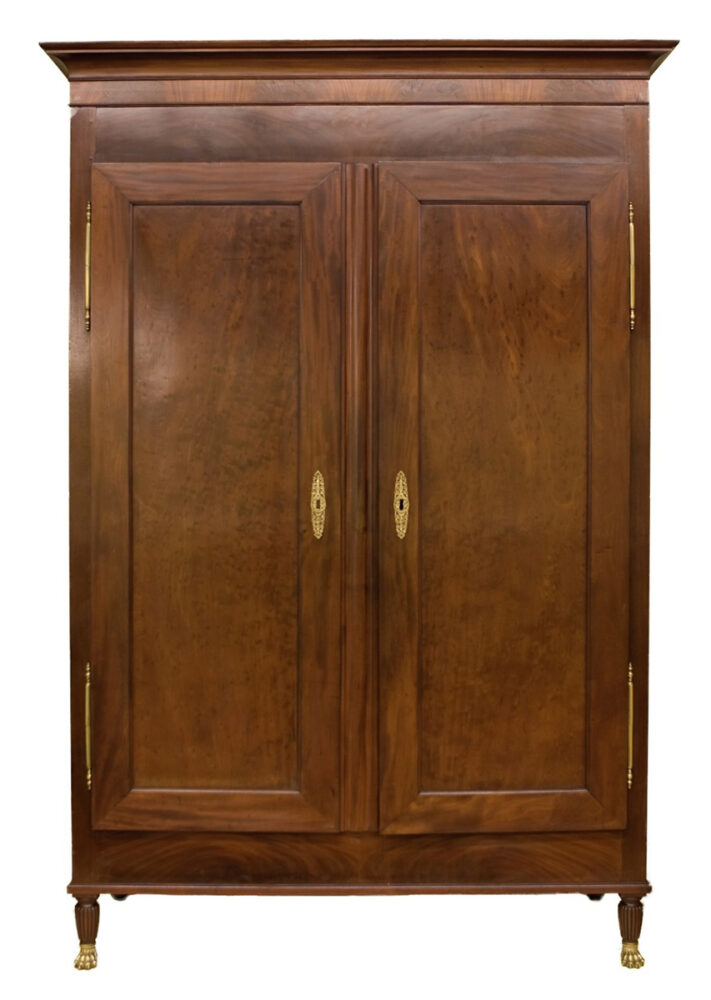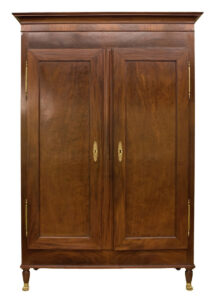Francois Seignouret
Francois Seignouret, a financially successful businessman and investor, became known as one of the greatest cabinetmakers in New Orleans, though there is no evidence that he ever made furniture with his own hands.

The Historic New Orleans Collection
Armoire attributed to Francois Seignouret, ca. 1800-1825.
Francois Seignouret was a leading businessman and tastemaker in early nineteenth-century New Orleans. He ran a successful shop on Royal Street where locally made furniture was sold alongside imported house decorations and French wine. Although he became known as one of the greatest cabinetmakers in New Orleans by twentieth-century collectors, there is no evidence that he ever made furniture with his own hands. Instead, most of his wealth came from his investment in real estate in New Orleans and Bordeaux, France, and his operation of a vineyard in the French countryside.
Bordelaise in Nouvelle Orleans
Francois Seignouret was born in Bordeaux in 1783, the son of Rose Guillard and Pierre Seignouret, a third-generation tailor. Young Seignouret likely learned the trade of his forebears. In December 1807 he and his younger brother Joseph boarded the ship Le Franklin in Bordeaux, seeking prosperity in the Louisiana Territory. When they disembarked in New Orleans in February 1808, the brothers found a bustling port city where French was spoken more than English. There were many other men from Bordeaux in New Orleans at the time, including the Maurian, Théard, and Peychaud families, who provided a network for Seignouret.
Francois and Joseph Seignouret soon went into business, not as tailors, but as upholsterers, a skill that enabled them to match fabric to furniture and architecture, allowing them to outfit entire homes. Seignouret’s first advertisement, posted at the end of 1810, lists fine furniture, mirrors, carpets, trimmings, and wallpaper, all imported from New York to sell to New Orleans customers.
On December 16, 1814, Seignouret volunteered for the local militia. He served as a grenadier in Plauche’s Battalion, contributing to the gunfire that turned back the British attack in the Battle of New Orleans. Seven years later General Andrew Jackson, leader of the battle, purchased several pieces of furniture from the former grenadier.
Seignouret had other prominent clients in New Orleans. In 1818 the archdiocese purchased six armchairs for use in St. Louis Cathedral. In 1819 the archdiocese shopped at Seignouret’s store again, buying a massive mahogany armoire for the Presbytere.
Mahogany was common in Seignouret’s Royal Street shop, where customers could find day beds, armoires, dining tables, and sideboards made of the exotic hardwood. But the merchant’s specialty was his ability to fully furnish a home. Jean Francois Merieult, Seignouret’s neighbor, fully updated his home in 1817 with furnishings from the store. In addition to a sideboard, dining tables, glass-front bookcases, a dozen gilt chairs, and a horsehair sofa, Merieult purchased mirrors, carpets, mattresses, paintings, tablecloths, and green tassels. The total, with installation, was more than $1,000 (the equivalent of more than $22,000 in 2023). Merieult died before he paid off the bill.
Seignouret’s New Orleans business ventures were not limited to home furnishings; he also invested in real estate and profited from the trade of enslaved people. In addition to his large store and Royal Street mansion, Seignouret owned property on Chartres and Bourbon Streets that he rented out as residences and businesses. He first purchased an enslaved person, a woman named Marguerite, in 1810. In the next decade, he bought and sold at least six more enslaved men and women.
Family and Business in Bordeaux
In New Orleans Seignouret was married to Elizabeth Vigoulet, a native of Bordeaux. Elizabeth’s nephew Jacques Descrimes came from Bordeaux around 1822 to learn business from Seignouret, becoming his partner in 1836 and managing all his New Orleans concerns. By that time Seignouret was spending most of his time in Bordeaux, where he was growing his investment portfolio and family.
In Bordeaux, Seignouret had five children with Corinne Descrimes, sister of his business partner and niece of his wife. On October 13, 1829, he purchased the estate of Terrefort, just north of the city of Bordeaux. The seventeenth-century chateau came with sixty hectares of abandoned vineyard. Corinne worked to bring the vineyard back into production while Seignouret traveled back and forth across the Atlantic. In 1838 Seignouret purchased eight lots in downtown Bordeaux, including a glass-bottle manufactory, a large mansion, and a site that he would develop into the “Salle Franklin,” a theater named for the first ship he took to New Orleans. By 1840 his Royal Street shop was thriving under the management of his brother Joseph, an accomplished upholsterer, and his nephew/brother-in-law Jacques Descrimes, selling imported Bordeaux wines as well as home furnishings.
Francois Seignouret died in his home in Bordeaux on Christmas Day 1852. His estate was valued at $1.5 million gold francs (more than $50 million in 2023), including thirty buildings in France and Louisiana, a large portfolio of investments in railways, canals, and maritime insurance, two-and-a-half tons of indigo in storage in Bordeaux, seven hundred barrels of wine at Terrefort, and a stock of wine in Louisiana worth almost $300,000 francs. Seignouret’s sons, Pierre-Edouard and Emile, carried on the New Orleans upholstery, furniture, and wine warehouse for a few years before selling off the Royal Street store and wine import business to C. Cavaroc and Pierre Brulatour. Corinne Descrimes continued to run the vineyard at Terrefort, working with her sons in the export company. The vineyard grew in family hands into the twentieth century and still produces wine today.
